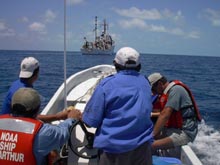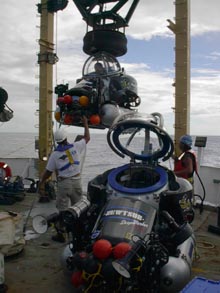
Scuba divers return to the NOAA Ship McArthur from an away mission on a skiff owned and operated by a local Belizian dive company*. (Photo courtesy of Steve Gittings)
Whale Sharks
May 17, 2001
Jesse Duncan, Third Assistant Engineer
NOAA Ship McArthur
![]() View a video of a whale shark (QuickTime, 785k). Requires QuickTime
View a video of a whale shark (QuickTime, 785k). Requires QuickTime ![]() .
.
There was an air of nervous excitement and anticipation as we departed McArthur and headed off in a small skiff towards Gladden Spit, which is situated off the coast of Belize. The group I would be diving with consisted of Ian Griffith, who works for Nuytco as a sub tech and dive supervisor for the Sustainable Seas project, which is run by Dr. Sylvia Earle, an Explorer-in-Residence at the National Geographic Society, Robert Rowe, who is a fellow engineer, Nicole Cabana, who is a NOAA Corps officer, John Halas, a biologist for the National Marine Sanctuaries Program, and Rachel Graham from The Darwin Institute in the UK, as well as a sub pilot and our guide for the trip.
During gear preps the people who had already seen the whale sharks spoke of the experience in reverent awe. "They come out of nowhere and act as if they are going to slam right into you, but somehow maintain mere inches of clearance as all 30 feet of their massive body glides silently past you." In order for those of us who had not yet seen it to go experience it for ourselves, many of the scientists who had already seen it volunteered to stay behind. It was an extremely generous gesture on their part. Also, Rachel put forth a lot of effort to give us the opportunity. I was one of three crew from the ship.
Out at the site we were given a pre-dive briefing by Rachel. "We are all going to drop down to about 90 to 100 feet and look for the school of spawning dog snapper. Once we find them, we are going to wait for the whale sharks to come around. Be careful not to get too close to the snappers because they will bite if they are aggravated." With that we were off the boat and on our way down to 90 feet in search of snapper. As we descended, I looked over to my right and Ian was fiddling with a high powered underwater digital camera. Yes! we are going to get this on tape!

Jesse Duncan, Third Assistant Engineer on the NOAA Ship McArthur in the engine room. (Photo courtesy of Steve Gittings)
As we approached our depth of 90 feet I noticed what turned out to be several black finned tuna. Having never seen tuna in the water, I was surprised by their speed and power, and was having a fine time just watching them swim around. Then I looked up. Several thousand snappers, each as big as a large dive fin and weighing in at about 20-30 pounds, were swimming in a formation that resembled a tornado and looked just as awesome, and every bit as powerful. The mass ranged in depth from 110 feet all the way up to within 5 feet of the surface.
At first the snappers were slow moving and rather docile, but they slowly branched off like a tear drop moving horizontally. A narrow stream made up of several fish would scream out from the center of the mass and form a little ball that appeared to still be attached to the main school. This new group would then erupt in a frenzy, and disperse clouds of sperm into the water hoping to fertilize the eggs of the few females in the group. There were no obvious physical differences between the males and females but I was later told that the females were a small minority in the group. For several minutes, I watched as the snapper left the main body of the school to perform their acts of mating and then return to the cyclone.
(top)
Then the sea darkened, as the first whale shark glided less than 30 feet overhead, temporarily blocking the quickly fading rays of sunlight in our early evening endeavor. Its tail slowly moving back in forth in such a careful and deliberate action, it looked as if it had taken a thousand years to perfect. Then it was gone. I swam over to Nicole to exchange tank pressure levels. As she was glancing at my gauge, she caught out of the corner of her eye what I had just noticed a split second before her -- a huge, seemingly smiling, 25-30 foot shark swimming down directly toward us! We floated there paralyzed with excitement and anticipation to see what would happen next, as we obviously had no control over what the shark was going to do. At that point we were at about 60 feet and the shark had changed course and was coming down at a fairly shallow angle traveling in from our right. It's massive gray, white spotted body passed within about 15 feet of us and continued on downward to the bottom, disappeared into the abyss. Nicole grabbed my arm and shook me as if to make sure we weren't imagining what we had just seen. It was an indescribable feeling. Very peaceful. I will never forget it as long as I live.
As everyone was getting a bit low on air at this point, it was time to head toward the surface and finish the dive in about 15 feet of water while taking one final look around. On our way to the surface we were ambushed by a large group of snapper who, being tired from a quick bout of mating, were on their way back to the group. Several of the divers were bumped and nudged as the fish stampeded past. I, having newly adopted a persistent cramp in my right foot that left me holding my fin in one hand while trying to work out the cramp with the other and keep upright with my good foot at the same time, was made a prime target and was urged to move several times by the testosterone laden males. I assume, of course, that they were males because I don't think the poor females had much fight left in them after that aggressive night on the open ocean.

Even though the scuba divers were on an away mission, the DeepWorker 2000 submersibles continued to explore and conduct research of the hard bottom communities in the waters off Belize.
Back at the boat many of the divers were loading their gear back into the boat and exchanging stories. I wanted to be one of the last in the boat -- just in case... Not half a minute after seeing everyone gather around the boat. The biggest shark I had seen that dive headed straight for the boat and at the last instant arched sharply down and appeared to brush the feet of everyone still dangling in the water with one powerful swoop of it's six foot tall tail, then headed directly underneath me at a depth of eight or so feet before departing. It then swam back up and broke the surface with its dorsal fin and headed back down to wherever it is that whale sharks go.
All of the divers reported close contact with the sharks. Robert was actually bumped in the leg at the beginning of the dive and turned around to discover that he was being politely ushered aside by a 30 foot whale shark.
On the way back to the ship, Rachel informed us that you can only see these sharks off the coast of Belize during the months of March, April, May, and June, and then only during a full moon. She said that they will be gone in another two to four days at the most and won't return until the next full moon, and historically June is not nearly as active as May. We were also very lucky to see the dog snapper spawning. They had never been observed spawning until about two years ago and very few people have ever seen it. All of the sharks we saw on our dive were tagged, many by Rachel, and are recorded and studied by her and her field crew throughout the season.
We loaded our gear back on the ship said our goodbyes just as the sun was setting. We bid Rachel fair well and good luck as she departed for her field station and home on the coast of southern Belize. Back on the ship, I spoke with some of the seasoned scientists and the Nyutco sub techs, who are all experienced commercial divers, and everyone was saying that this was one of the most amazing things any of them had ever seen.
The site we dove was declared a sanctuary a year ago due to Rachel and Will Heyman's research. Will is a scientist who has spent over seven years in Belize working with The Nature Conservancy to preserve and sustain Belize's natural resources. Whale sharks can grow to be over 60 feet long and survive on a diet of plankton and other micro-organisms found in the ocean. At the time they were feeding on the snapper eggs. They are easily identifiable by their wide body, large tail and wide mouth, which contains no teeth, like you would find on a carnivorous shark.
Definitely a nice break from all those long endless days on the high seas!
* NOTE OF CLARIFICATION. ALL events associated with this account occurred on a small skiff/vessel, Cubera, that was owned and operated by a local Belizian dive company. Although these events were part of the Sustainable Seas Expeditions/Islands in the Stream, NOAA policy strictly forbids the use of NOAA ships(e.g. McArthur) or their support vessels by non-NOAA certified divers. Rachel Graham of the UK Darwin Initiative in Belize arranged for the Cubera to support this activity.
Sign up for the Ocean Explorer E-mail Update List.











































